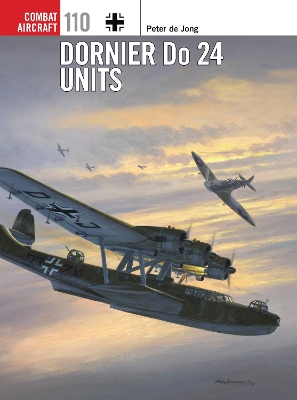Combat Aircraft
1 primary work • 2 total works
Book 110
Perhaps the most seaworthy flying boat ever built, the elegant, tri-motor Dornier Do 24 served with both the Allied and Axis forces in very different parts of the globe during World War 2, garnering an excellent reputation along the way This study uses archival records, first-hand accounts and revealing photographs to illuminate the combat career of this remarkable aircraft for the first time in English. The German-built Do 24 was the Netherlands Navy's principal aerial asset during the Japanese invasion of the East Indies. While the survivors of that ordeal served in the Australian Air force, in occupied Holland and France production continued apace and the Do 24 equipped the German Air-Sea rescue service, whose crews loved and respected the machine. The type witnessed the rise and fall of the Luftwaffe over all the European seas, took part in the desperate evacuations of Wehrmacht troops on the Baltic in the face of the overwhelming Soviet advance, and was pressed out of service only with the withdrawal of Spanish Do 24s in 1969. This volume tells the long and eventful story of the faithful Do 24 in full.
Beating its biplane rivals in a 1936 Reich Air Ministry design competition, the Arado Ar 196 provided the Kriegsmarine with possibly the best shipborne reconnaissance seaplane of World War II. Replacing the Heinkel He 60 biplane as the standard catapult-launched floatplane embarked on the Kriegsmarine's capital ships, the Ar 196 flew an assortment of combat missions during World War II, including coastal patrol, submarine hunting, light bombing, general reconnaissance and convoy escort sorties. The first vessel to take its Ar 196A-1s to sea was the pocket battleship Graf Spee, which embarked two in the autumn of 1939. The battleships Bismarck and Tirpitz could carry six Arados each, the battlecruisers Gneisenau and Scharnhorst four and smaller pocket battleships and cruisers two. Shore-based aircraft were also operated from coastal ports on the Channel, Baltic, North Sea and Bay of Biscay coasts, as well as in the Balkans and Mediterranean.
In this title, supported by an excellent selection of photographs and full-colour illustrations, Peter de Jong explores the history of the Arado Ar 196, detailing their development and assessing the combat capabilities of one of the last fighting seaplanes.
In this title, supported by an excellent selection of photographs and full-colour illustrations, Peter de Jong explores the history of the Arado Ar 196, detailing their development and assessing the combat capabilities of one of the last fighting seaplanes.

